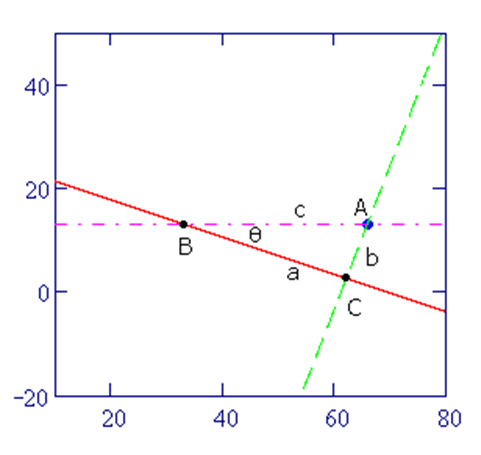Distance from a Point to a Line
When I solve a math problem it usually helps to draw a picture. Frequently the picture suggests that I would like to know the shortest distance from a point to some line. There are multiple ways of getting that information - although asking Siri failed. In this section I will describe two methods. In the chapter on vectors, I will describe yet another way (vector projections) which is, in my opinion, often the easiest.
Example:
Point A has coordinates $(66,13)$ and the solid line is $y=-0.36x+25$. What is the shortest distance
from Point $A$ to the line $CB$, making the angle at $C$ a $90^{\circ}$ angle?
1st answer: If we knew the angle, $\theta$, we could use
the standard trig functions to find the length of line segment $b$, $sin(\theta)=b/c$. As it happens,
we know the slope of line $a$ and we can calculate the angle that it makes with the horizontal line, $c$
because the $arctan$ of a slope is the angle with the horizontal.
$$\theta=\left|atan(-.36)\right|\cdot 180/\pi=19.798^{\circ}$$
Next we need to know the length of $c$, which can be calculated if we can find the coordinates of point $B$. Since
$c$ is horizontal, its $y$ parameter must be the same as $A$, which is $13$. Then using the equation of line $a$,
$y=-0.36x+25$, we can find $x$ at point $B$, $13=-0.36x+25$. Solving for $x$ we get the point $B$ as
$(33.33,13)$. Obviously, the length of segment $c$ is just $66-33.33=32.667$. Now using $sin(\theta)\cdot c=b$,
the answer is found.
$$32.667\cdot sin(\theta)=11.064 \text{ distance units.}$$
2nd answer: We know that all perpendiculars to a known line have a slope that is $-1/slope$ of the line. Using that fact and the point $A$, we can substitute $(66,13)$ into a line equation with the perpendicular slope to get $13=(1/0.36)\cdot66+y\,intercept$. Solving for $y\,intercept$, we get $-170.33$. So the equation of the perpendicular line is $y=(1/.36)\cdot x-170.33$. Using the perpendicular equation, and the original line equation, we can solve for their intersection point, $C$. $$y=(1/0.36)\cdot x-170.33 \text{ Perpendicular Equation} \tag{EQ 1} \label{EQ 1}$$ $$y=-0.36\cdot x+25\text{ Equation of Line } a \tag{EQ 2} \label{EQ 2}$$ Since Equations $\eqref{EQ 1}$ and $\eqref{EQ 2}$ intersect at point $C$, simultaneously solve the two equation for $x$ and $y$. $$\left[\begin{array}{c}x\\y\end{array}\right]=\left[\begin{array}{c} 62.251\\2.59\end{array}\right]\Longleftarrow \text{Calculated coordinates of point }C$$ Now we can use the distance formula to solve for $b$. Just plug in point $A=(66,13)$ and point $C=(62.251,2.59)$. $$b=\sqrt{(66-62.251)^{2}+(13-2.59)^{2}}=11.064 \text{ distance units},$$ or $$b=|C-A|=11.064 \text{ distance units.}$$